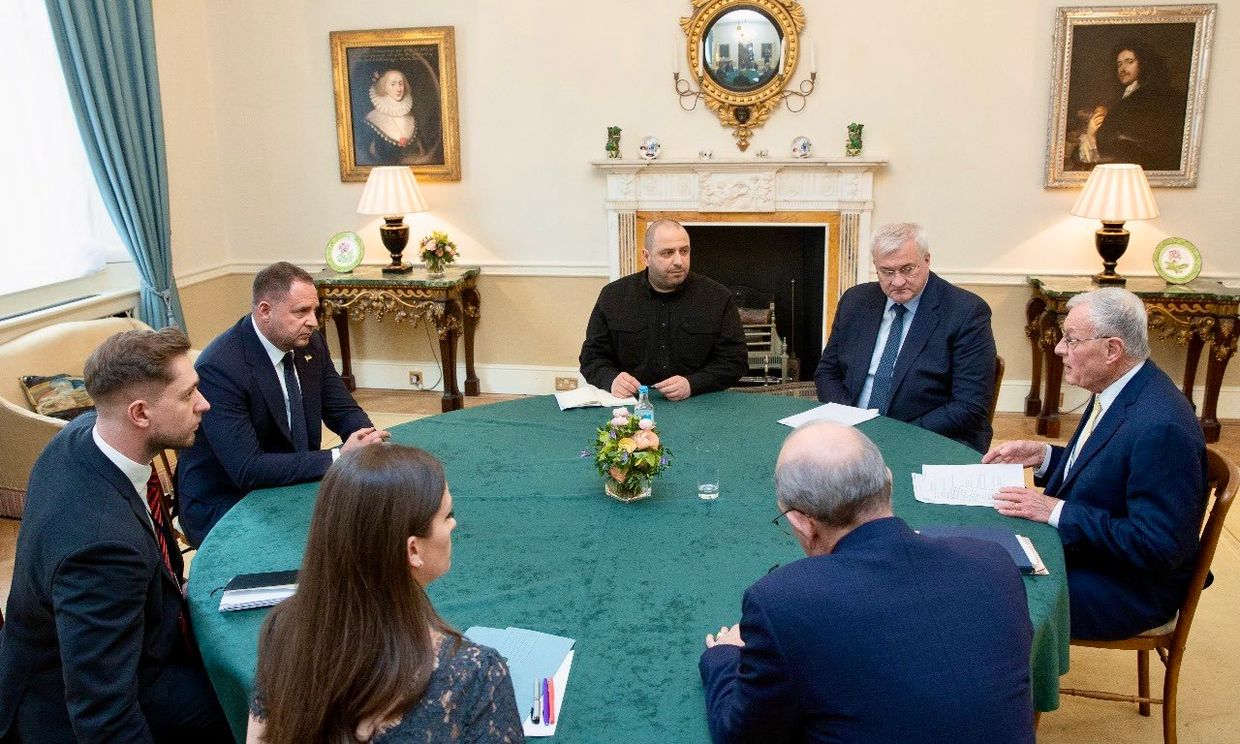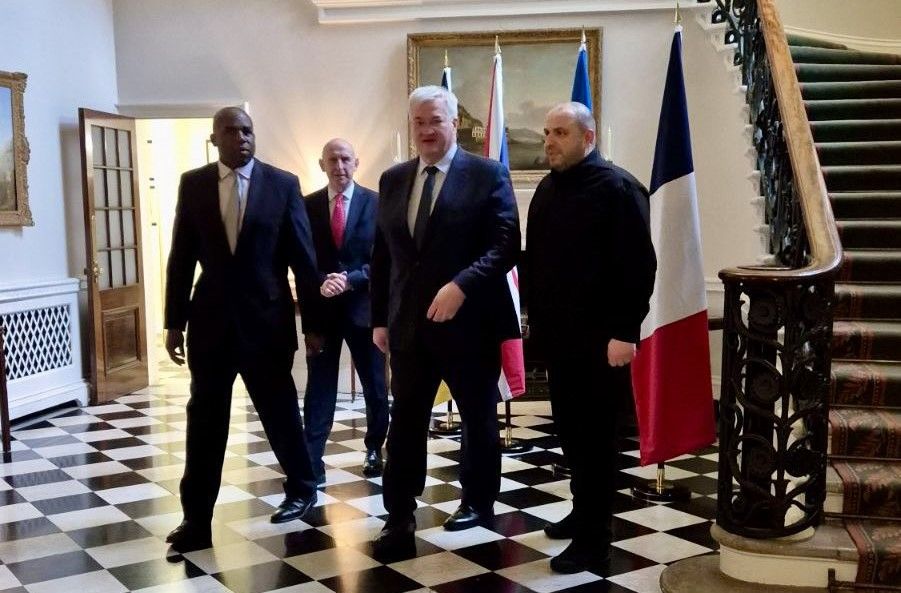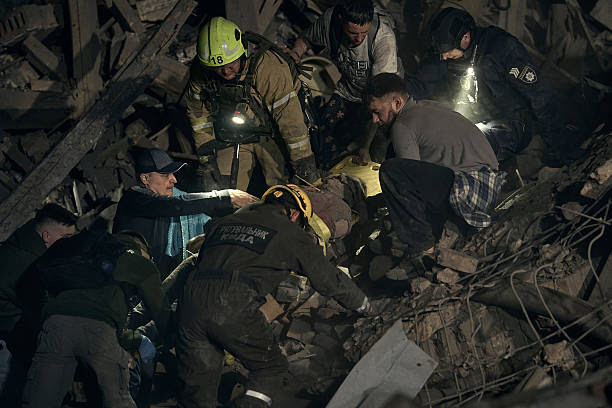As the U.S. proposal to recognize Russian control of Crimea draws fierce Ukrainian resistance, Russia unleashes one of its deadliest attacks on Kyiv, killing nine and injuring dozens in a stark reminder of what “Russian peace” looks like
Summary of the Day – April 24, 2025
A diplomatic crisis erupted over the Trump administration’s seven-point peace proposal that would recognize Russia’s control of Crimea and other occupied territories—a plan swiftly rejected by Ukraine as unconstitutional. Simultaneously, Russia launched its deadliest attack on Kyiv in months, killing nine and injuring over 70 civilians, while a separate drone strike on a civilian bus in Dnipropetrovsk Oblast killed nine more. Ukrainian forces responded with their deepest strike in months against a Russian drone factory in Tatarstan, over 1,000 kilometers from the border. The scheduled ministerial-level peace talks in London collapsed, with U.S. Secretary of State Rubio and European foreign ministers withdrawing after Ukraine’s refusal to consider territorial concessions, as the Kremlin continues deploying chemical weapons against Ukrainian positions in violation of international law.
The Deal Breaker: Trump’s Peace Plan Demands Ukrainian Territorial Concessions
The diplomatic impasse between Ukraine and the United States sharpened dramatically as details of Trump’s “final” peace proposal emerged. According to reports from Axios and The Telegraph, the U.S. plan would require Washington to formally recognize Russia’s annexation of Crimea—a step never taken by any U.S. administration since Russia’s 2014 occupation—while accepting Russian control over parts of four other Ukrainian regions: Donetsk, Luhansk, Kherson, and Zaporizhzhia.
“Ukraine does not recognize the occupation of Crimea. It is our territory, the territory of the Ukrainian people—there is nothing to discuss,” Zelensky declared on April 22, drawing a firm line that echoed across Ukraine’s political spectrum.
The plan represents a sharp deviation from America’s longstanding position, enshrined in the 2018 Crimea Declaration signed during Trump’s first term, which explicitly rejected Russia’s annexation. Ukrainian lawmaker Volodymyr Ariev warned that if implemented, the proposal would “set a very dangerous precedent that could plunge the world into numerous wars.”
Responding to Ukrainian resistance, Trump posted on his Truth Social platform: “Nobody is asking Zelensky to recognize Crimea as Russian Territory, but if he wants Crimea, why didn’t they fight for it eleven years ago when it was handed over to Russia without a shot being fired?” This statement ignored the documented Russian military operation that seized the peninsula in 2014.
Diplomatic Downgrades: High-Level London Talks Collapse
Scheduled high-level peace talks in London disintegrated on April 23 after U.S. Secretary of State Marco Rubio and Special Envoy Steve Witkoff canceled their participation. Their withdrawal followed Zelensky’s rejection of the Crimea proposal, and soon after, foreign ministers from the UK, Germany, France, and Ukraine also pulled out.

The Ukrainian delegation meets U.S. Special Envoy Keith Kellogg in London. (Ukraine’s Foreign Minister Andrii Sybiha / X)
The meeting was downgraded to lower-level discussions among officials, with Ukraine’s Foreign Minister Andrii Sybiha, Defense Minister Rustem Umerov, and Presidential Office Head Andriy Yermak still traveling to London for bilateral meetings.
“An immediate, complete and unconditional ceasefire should be the first step towards the start of negotiations on achieving a just and lasting peace,” Yermak said after the meetings, reiterating Ukraine’s stance that any territorial concessions cannot precede a full ceasefire.

U.K. Foreign Minister David Lammy, U.K. Defense Minister John Healey, Ukraine’s Foreign Minister Andrii Sybiha, and Ukraine’s Defense Minister Rustem Umerov (L-R) in London, U.K.. (Andrii Sybiha/X)
U.S. Vice President J.D. Vance intensified pressure on Ukraine during a visit to India, stating that the administration had presented a “very explicit proposal” to both sides. “It’s time for them to either say yes or for the United States to walk away from this process,” Vance said, adding that both sides would need to “give up some of the territory they currently own.”
White House Press Secretary Karoline Leavitt criticized Zelensky for discussing the negotiations publicly, claiming he was “moving in the wrong direction” and that “these should be closed door negotiations.”
Kremlin’s Hard Line: Russia Rejects European Peacekeepers, Demands Full Ukrainian Withdrawal
Russian officials firmly rejected key aspects of any peace deal that would include international peacekeepers in Ukraine. Russian Federation Council Chairperson Valentina Matvienko declared Russia would “never participate” in any negotiations discussing the deployment of European troops to Ukraine, calling such a prospect “unacceptable.”
Kremlin Spokesperson Dmitry Peskov told French news magazine Le Point that the war would “end immediately” if Ukraine withdrew from all four oblasts Russia has illegally claimed—Donetsk, Luhansk, Kherson, and Zaporizhzhia—despite Russia not fully controlling these territories.
“These four regions are inscribed in our constitution as an integral part of Russia,” Peskov insisted, reiterating Moscow’s maximalist position. He also praised Trump as a “strong leader” willing to engage in dialogue, adding, “Putin appreciates strong men.”
Despite Trump’s repeated claims of progress, Russia has continued to reject the March 2025 U.S. proposal for a full 30-day ceasefire and maintains offensive operations across multiple fronts.
Kyiv Burns: Russian Missile Barrage Kills Nine, Injures Over 70
Russia launched a devastating missile and drone attack on Kyiv overnight on April 24, killing nine people and injuring more than 70, including six children. Ukrainian officials described it as one of the largest strikes on the capital in recent months.

Rescuers and civilians worked to pull victims from the rubble of a missile strike on a residential building resulting in two deaths and 54 injured in Kyiv, Ukraine. Among the injured were six children and one pregnant woman. (Kostiantyn Liberov/Libkos/Getty Images)
Multiple explosions rocked the capital around 1:00 a.m. local time, followed by additional blasts around 4 a.m. The attack targeted residential areas in the Shevchenkivskyi, Holosiivskyi, Sviatoshynskyi, and Podilskyi districts, leaving fires burning in residential buildings and damaging commercial structures.
“Russian peace in all its glory,” said Kyiv City Military Administration chief Tymur Tkachenko, describing the scene of destruction.
The massive, combined strike also hit Zhytomyr, Dnipropetrovsk, Kharkiv, Poltava, Khmelnytskyi, Sumy, and Zaporizhzhia oblasts, though Kyiv suffered the worst damage. Poland’s Air Force scrambled allied fighter jets to protect Polish airspace from missiles that might stray across the border.
Death on the Road: Nine Killed in Bus Strike in Marhanets

A Russian drone attack against the town of Marhanets in Dnipropetrovsk Oblast on April 23 killed nine people and injured at least 42 when it struck a bus carrying company employees. The victims included two men and seven women, according to Governor Serhii Lysak.
Marhanets, with a pre-war population of 45,000, sits near the destroyed Kakhovka Reservoir and Russian-occupied parts of Zaporizhzhia Oblast, making it vulnerable to attacks. The strike was part of a broader pattern of intensified Russian attacks against Ukrainian civilian infrastructure, even as Kyiv proposed a 30-day truce on such strikes.
“The bloodiest attack was in the village of Marhanets, Dnipropetrovsk region, where Russian kamikaze drone hit a packed passenger bus, killing nine civilians and injuring 42,” reported regional administration head Serhiy Lysak.
Ukraine Strikes Deep: Drone Attack Hits Russian Drone Factory 1,000km from Border
Ukrainian forces conducted a daring long-range drone strike against a Russian facility producing combat drones in the Republic of Tatarstan—more than 1,000 kilometers from Ukraine’s border—on April 23, according to Ukraine’s General Staff.
The strike targeted a plant in the Alabuga Special Economic Zone that reportedly manufactures up to 300 Iranian-style Shahed drones and their Russian variants per day. “The strike is a justified response against a strategic military site used to support Russia’s aggression and terror against Ukraine and Ukrainian civilians,” the General Staff stated.
Ukrainian Center for Countering Disinformation Head Lieutenant Andriy Kovalenko noted that over 6,000 Shahed-type drones were produced at Alabuga last year, along with thousands of decoy drones designed to overwhelm Ukrainian air defenses. Russia has ordered the facility to produce between 8,000-10,000 Shaheds and 15,000 decoy drones in 2025.
The Russian Defense Ministry acknowledged that Russian forces shot down a drone over Tatarstan but provided no details about damage to the facility. This attack ranks among Ukraine’s deepest strikes into Russian territory since the full-scale invasion began.
Chemical Warfare: Russia Continues Prohibited Weapons Use Against Ukrainian Forces
Russia continues to deploy chemical weapons against Ukrainian forces and civilians in violation of the Chemical Weapons Convention (CWC), to which Russia is a signatory. Ukrainian Deputy Head of the Main Department of Anti-Mine Action, Civil Protection, and Environmental Safety Colonel Valeriy Veber reported on April 23 that Ukrainian forces recorded 767 cases of Russian forces using chemical weapons in March 2025 alone, and 7,730 cases since February 2023.
The Ukrainian Main Military Intelligence Directorate (GUR) revealed that Russian forces are dropping RG-Vo hand grenades containing riot control agents onto Ukrainian positions near Shcherbaky in western Zaporizhia Oblast. Ukrainian military officials also identified a capsule with concentrated chlorobenzylidenemalononitrile (CS) gas, a type of riot control agent banned under the CWC, on Russian Shahed drones.
These chemical agents are reportedly being used to disperse poisonous substances among both military targets and civilian populations—a clear violation of international conventions on warfare.
Kremlin’s Manpower Concerns: Russian Military Surveys Troops About Post-War Plans
Russian propagandist Anastasiya Kashevarova claimed on April 17 that the Kremlin assigned Russia’s military chiefs of staff to survey contract servicemen and mobilized personnel about their intent to reenlist should Russia complete its war in Ukraine. This rare acknowledgment of potential demobilization plans suggests growing Kremlin concern about force retention after any ceasefire or peace deal.
According to Kashevarova, the Russian Ministry of Defense is attempting to retain active servicemen by offering full social benefits, subsidized rent, monthly salaries of 100,000-to-200,000 rubles ($1,225 to $2,450), 60 days of paid leave annually, and other incentives. The Russian government also signed a decree on April 19 that will increase salaries for military and law enforcement personnel by 4.5 percent starting in October 2025.
Russian military bloggers expressed skepticism about these retention efforts. One acknowledged that field commanders have imposed requirements for servicemen to document their refusal to reenlist after facing pressure from senior commanders about the need to maintain force levels. Another blogger suggested that promised financial incentives would be futile without addressing widespread logistics problems, lack of career advancement opportunities, and the military’s diminishing credibility due to exaggerated field reports.
Phantom Citizenship: Russia Expands Military Eligibility to “Stateless” People
The Russian government submitted a bill to the State Duma on April 18 that would allow stateless people to serve in the Russian Armed Forces, part of the Kremlin’s ongoing effort to decrease military service eligibility requirements to recruit more troops. The bill follows Putin’s March 20 decree stipulating that Ukrainian or “foreign” citizens living in occupied areas of Ukraine must either “regulate their legal status” or leave their homes or risk deportation.
This expansion may be intended to illegally coerce Ukrainians in occupied regions into military service, potentially forcing them to fight against their own country. Meanwhile, some Russian federal subjects continue to struggle with recruitment targets despite dramatically increased financial incentives. Sverdlovsk Oblast’s Ministry of Education has offered university students facing academic problems the opportunity to fight in Ukraine in exchange for debt forgiveness and a chance to continue their studies upon return—a desperate measure after the region met only 25 percent of its required recruitment target.
Battlefield Dynamics: Russian and Ukrainian Forces Exchange Blows Across Multiple Fronts
Russian forces recently advanced in Kursk Oblast near the international border as part of efforts to push Ukrainian forces from their remaining positions in the area. Geolocated footage showed Russian advances south of Guyevo near Sudzha, though Ukrainian forces maintain positions in Gornal. Fighting continues southwest of Sudzha in Oleshnya and Gornal.
In the Toretsk direction, both sides made territorial gains. Ukrainian forces advanced in western Toretsk, while Russian forces seized Sukha Balka southwest of Toretsk and advanced along a waste heap in northern Toretsk. The commander of a Ukrainian battalion operating in the area reported that Russian forces are using armored personnel carriers and motorcycles to quickly approach Ukrainian positions, with tanks transporting infantry as close as possible to the front lines.
In the Pokrovsk direction, geolocated footage showed Russian forces advancing along Moskovska Street in central Tarasivka northeast of Pokrovsk. Russian claims of completely seizing Tarasivka remain unconfirmed. Russian forces also made advances in the Kurakhove direction, pushing northwest of Rozlyv.
Ukrainian forces scored their own advance near Borova, with geolocated footage indicating a marginal advance northwest of Nadiya east of Borova, though this advance did not occur recently.
The Hunt for Foreign Fighters: 1,500 Mercenaries from 48 Countries Identified in Russian Army
An investigation by the independent Russian media outlet Important Stories identified more than 1,500 foreign mercenaries from 48 countries recruited to fight for Russia against Ukraine. Despite Putin’s earlier claims that Russia had “no need” for foreign fighters, the data reveals widespread recruitment through official military selection points in Moscow.
Nepal tops the list with at least 603 nationals joining the Russian army, followed by Tajikistan (86), Uzbekistan and Belarus (71 each), Sri Lanka (64), Kyrgyzstan (64), China (51), Kazakhstan (59), and India (43). The influx of Nepalese recruits reportedly began in mid-2023, escalating to over 370 in October alone before declining following diplomatic protests from Nepal.
The total number is likely far higher, with CNN reporting in February that up to 15,000 Nepalese citizens could have been recruited. Ukrainian forces have confirmed the presence of foreign fighters on the battlefield, including the recent capture of two Chinese nationals in Donetsk Oblast. One detainee reportedly paid a middleman 300,000 rubles (about $3,500) to enlist in exchange for Russian citizenship.
Looking Ahead: The Peace Process at a Crossroads
As diplomatic efforts reach a critical juncture, both Ukraine and the United States face difficult choices. The Trump administration has made clear it will abandon mediation efforts if no progress is made soon, while Ukraine remains constitutionally unable to accept the recognition of Crimea as Russian territory.
Witkoff is expected to meet with Putin in Moscow on April 25, potentially offering a final opportunity to bridge the wide gap between the parties’ positions. However, with Russia continuing its brutal attacks on civilian targets and Ukraine firmly rejecting territorial concessions before a full ceasefire, the prospect of a breakthrough appears increasingly remote.
For now, the war grinds on, with each day bringing new casualties and destruction as the diplomatic dance continues in world capitals far from the sound of falling missiles and drone attacks that represent the daily reality for millions of Ukrainians.
